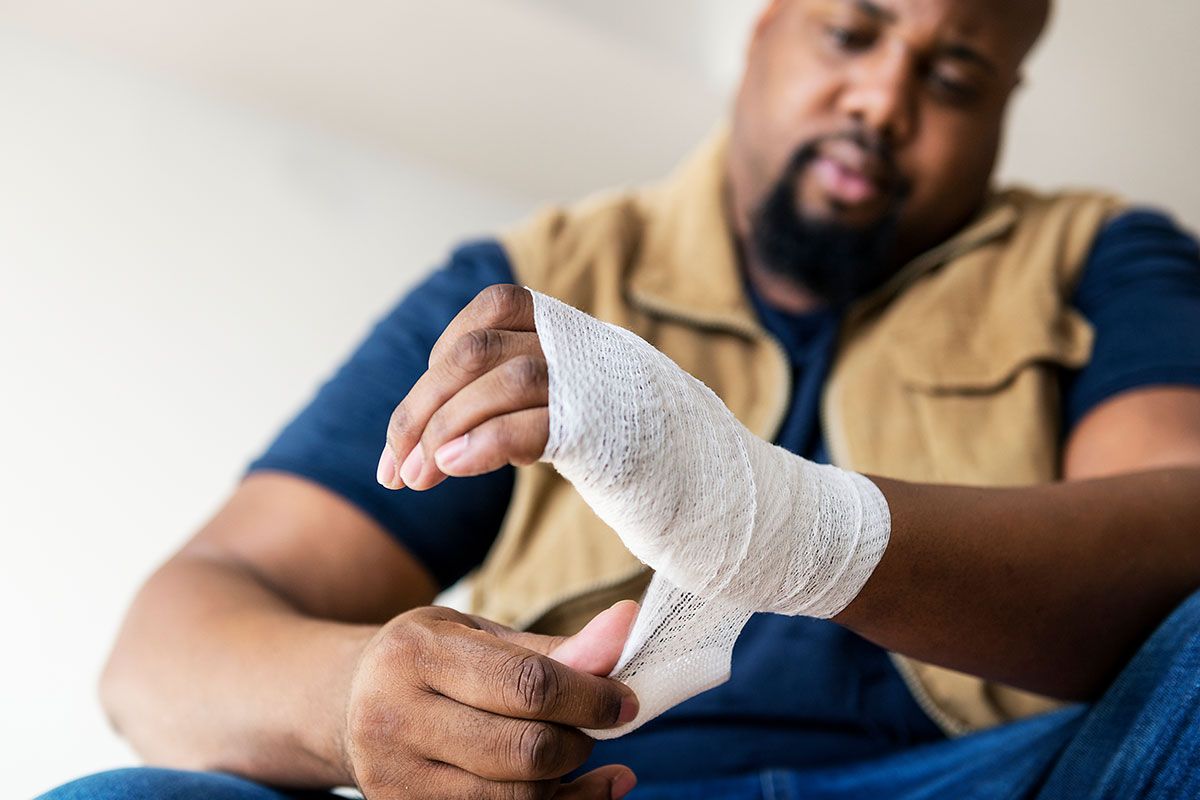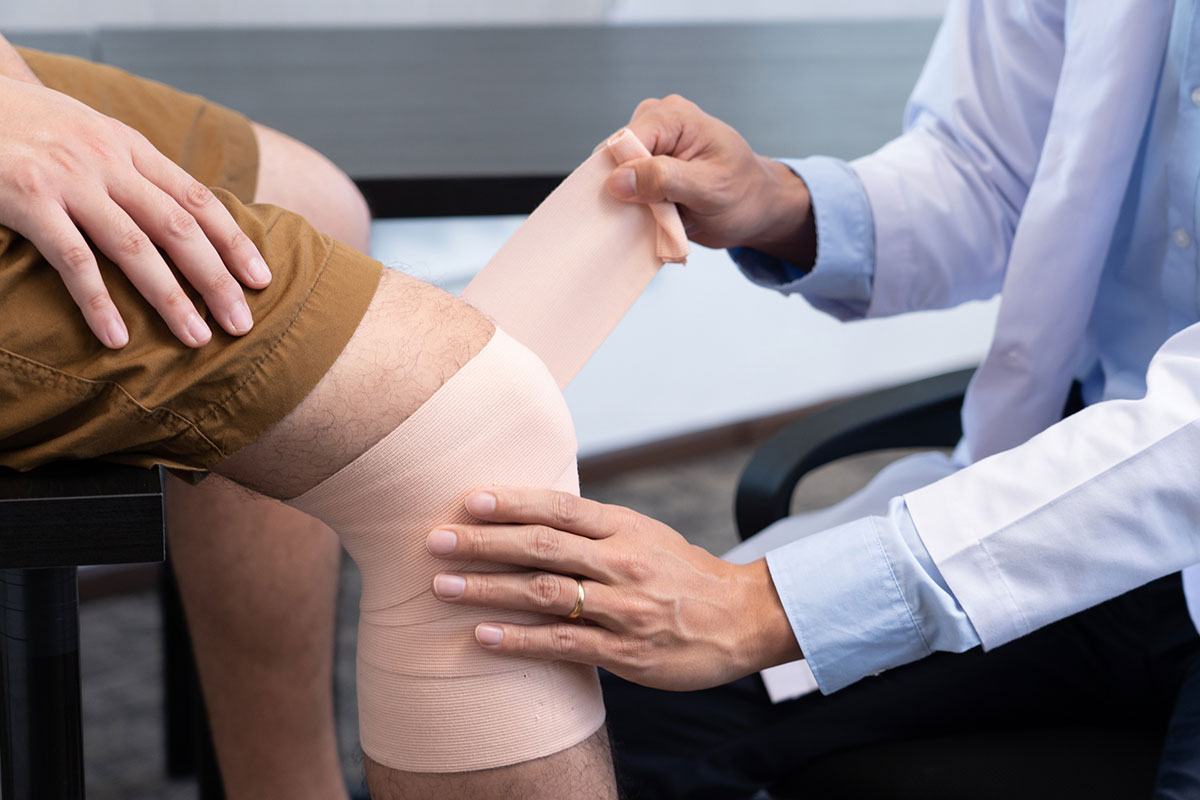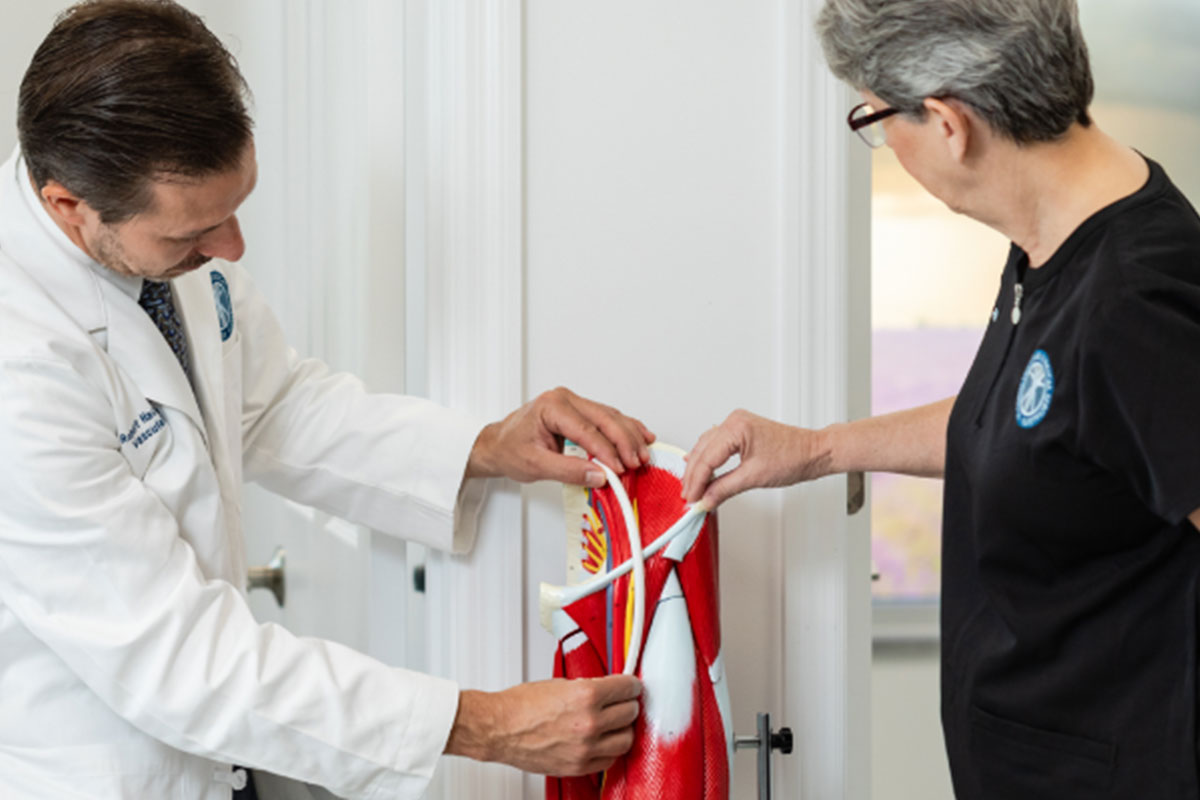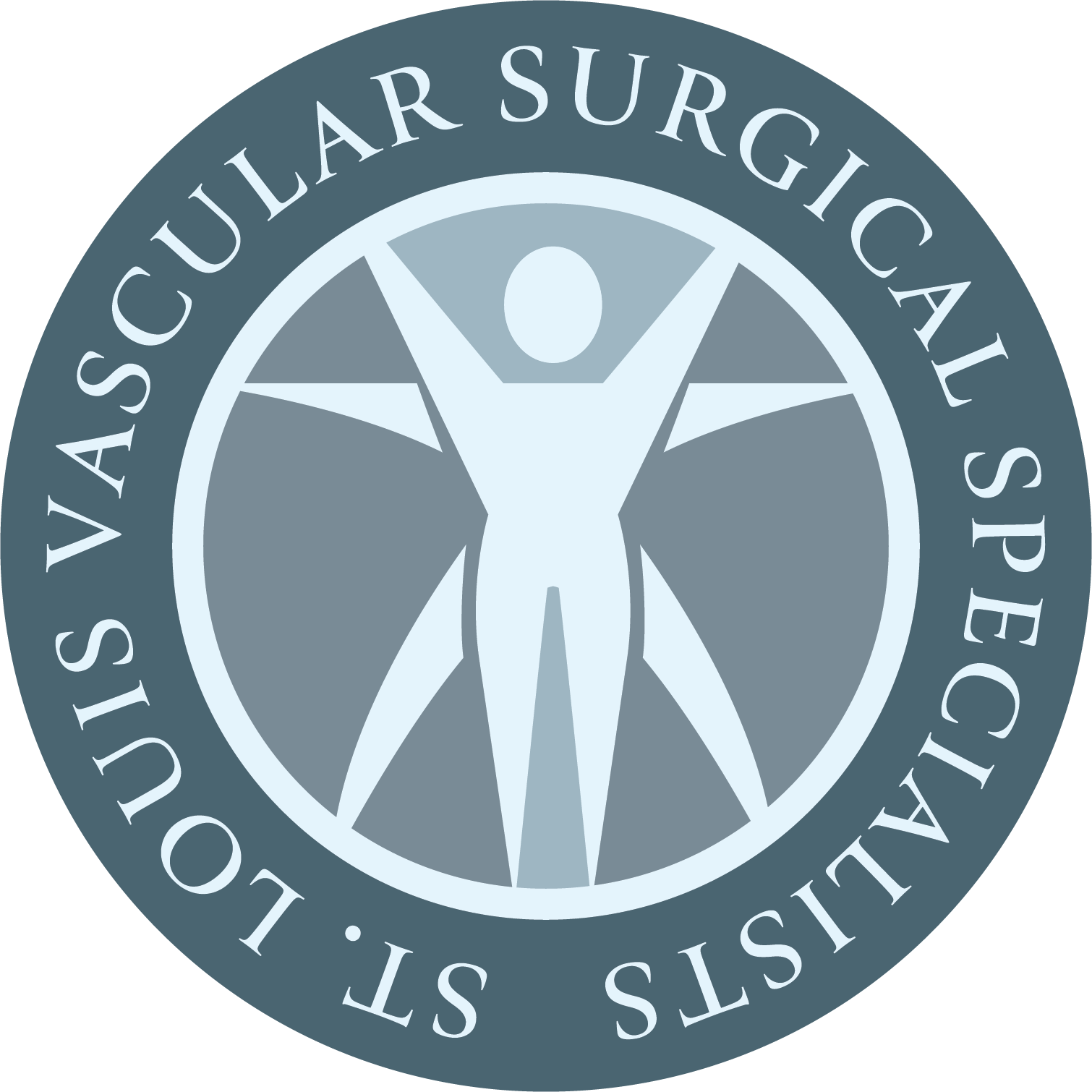Complex wound care is a specialized field dedicated to treating intricate wounds that may not heal naturally. At St. Louis Vascular Surgical Specialists, our team uses advanced techniques to address complex wounds resulting from vascular conditions, diabetes, trauma, or surgery. We take a multidisciplinary approach and tailor comprehensive treatment plans to promote healing, prevent complications, and improve quality of life.
Diabetic wounds
Diabetic wounds are a common complication of diabetes, characterized by slow or non-healing ulcers, primarily on the feet. They occur due to a combination of factors, including neuropathy, poor circulation, and impaired immune function. Neuropathy diminishes sensation, making diabetics prone to injuries they may not notice. Reduced blood flow hinders wound healing, while compromised immunity increases infection risk. Without prompt attention, these wounds can lead to serious complications, such as infection or even amputation.

Potential symptoms of diabetic wounds:
- Persistent pain or discomfort in the feet
- Redness or inflammation around the wound area
- Warmth to the touch
- Drainage or pus from the wound
- Foul odor emanating from the wound
- Development of a black, hardened tissue (eschar)
- Delayed healing, with the wound not showing signs of improvement over time
- Increased sensitivity to touch or pressure around the wound site
- Formation of blisters or calluses on the feet, especially over areas of high pressure or friction
Common causes of diabetic wounds:
- Neuropathy: Diabetes often damages nerves, particularly in the feet, leading to a condition called neuropathy. This nerve damage reduces sensation, meaning that individuals may not feel pain or discomfort from injuries or wounds. As a result, they may not notice cuts, blisters, or other injuries until they become severe.
- Poor circulation: Diabetes can damage blood vessels, leading to a condition known as peripheral artery disease (PAD). PAD reduces blood flow to the extremities, including the feet, which impairs the body’s ability to deliver oxygen and nutrients to the wound site. Without an adequate blood supply, wounds heal more slowly and are more susceptible to infection.
- Trauma or injury: Even minor trauma, such as stubbing a toe or stepping on a sharp object, can lead to wounds in individuals with diabetes. However, due to reduced sensation caused by neuropathy, these injuries may go unnoticed initially. Without prompt treatment, such wounds can worsen and become serious complications.
- Infection: Diabetes weakens the immune system, making individuals more susceptible to infections. Once a wound develops, it can provide a pathway for bacteria or fungi to enter the body, leading to infection. If left untreated, infections can further delay wound healing and may spread to deeper tissues, potentially resulting in cellulitis or osteomyelitis.
Venous wounds
Venous wounds, also known as venous ulcers or stasis ulcers, are skin wounds that develop due to impaired circulation in the veins, typically in the lower legs. They occur when malfunctioning valves in the leg veins fail to efficiently return blood to the heart, causing blood to pool in the legs. Over time, this increased pressure and swelling can lead to skin breakdown and the formation of venous wounds, often characterized by shallow, irregularly shaped ulcers.
Potential symptoms of venous wounds:
- Persistent swelling in the legs, ankles, or feet
- Discoloration of the skin, often appearing reddish-brown or purplish
- Itching or tingling sensation around the affected area
- Thickened, hardened, or leathery skin
- Pain or discomfort, particularly when standing or walking
- Open, shallow wounds or ulcers, typically located on the lower legs or ankles
- Drainage or weeping from the wound site
- Surrounding skin may feel warm to the touch
- Development of varicose veins or spider veins in the affected area

Common causes of venous wounds:
- Venous insufficiency: This condition occurs when the valves in the veins of the legs fail to function properly, leading to blood pooling in the lower extremities. When the blood pools, it increases pressure within the veins, causing them to stretch and weaken over time. The impaired circulation and increased pressure can eventually lead to skin breakdown.
- Deep vein thrombosis (DVT): DVT refers to the formation of blood clots in the deep veins of the legs. These clots can partially or completely block blood flow, causing swelling, pain, and increased pressure in the affected limb. If left untreated, DVT can lead to chronic venous insufficiency and, ultimately, the development of venous ulcers.
- Chronic venous hypertension: This condition is characterized by long-term elevation of pressure within the veins of the lower extremities. Chronic venous hypertension often results from venous insufficiency, obesity, or other factors that increase pressure within the veins. Over time, the sustained pressure damages surrounding tissues, causing venous wounds.
- Sedentary lifestyle: Lack of physical activity can impair the function of the calf muscles, which play a crucial role in promoting venous return to the heart. When muscles are inactive, they are less effective at pumping blood out of the lower extremities, leading to venous stasis, increased pressure within the veins, and, eventually, venous ulcers.
Arterial wounds
Arterial wounds, also known as ischemic ulcers, result from inadequate blood supply to tissues due to arterial circulation impairment. Typically found on the lower extremities, particularly the feet and toes, these wounds occur when narrowed or blocked arteries restrict oxygen and nutrient delivery to the affected areas. Reduced blood flow causes tissues to become starved of vital resources, leading to tissue death, ulceration, and delayed wound healing.

Potential symptoms of arterial wounds:
- Persistent pain, often described as sharp, throbbing, or cramping
- Cold sensation in the affected limb or extremity
- Pale or bluish discoloration of the skin, particularly in the toes or feet
- Delayed capillary refill time, where pressing on the skin results in slow color return
- Weak or absent pulses in the affected limb, such as the posterior tibial pulse in the foot
- Hair loss or decreased hair growth on the legs or feet
- Shiny, thin, or taut skin on the affected limb with a loss of elasticity
- Presence of non-healing or slow-healing wounds or ulcers, particularly on the toes or heels
Common causes of arterial wounds:
- Peripheral artery disease (PAD): PAD is the narrowing or blockage of arteries that supply blood to the extremities, most commonly the legs. Atherosclerosis, the buildup of plaque consisting of cholesterol, fat, and other substances, is the primary cause of PAD. As plaque accumulates, it restricts blood flow and results in arterial wounds.
- Diabetes: Diabetes is a significant risk factor for arterial wounds due to its detrimental effects on blood vessels. High levels of glucose in the blood can damage the walls of arteries, leading to atherosclerosis and reduced blood flow to the extremities. Additionally, diabetes can cause peripheral neuropathy, increasing the likelihood of injuries and wounds going unnoticed.
- Hypertension: High blood pressure can cause damage to the inner lining of arteries, making them more susceptible to the accumulation of plaque. Over time, this plaque buildup narrows the arteries, restricting blood flow to the extremities and increasing the risk of arterial insufficiency and subsequent wound formation.
- Hyperlipidemia: Elevated levels of cholesterol and triglycerides in the blood can contribute to the development of atherosclerosis, a condition characterized by the buildup of plaque in the arteries. As plaque accumulates, it narrows the arteries and restricts blood flow, damages the artery walls, and increases the risk of arterial wounds.
Pressure injuries
Pressure injuries, commonly known as pressure ulcers or bedsores, are localized damage to the skin and underlying tissue, usually over bony prominences, due to prolonged pressure or friction. They develop when pressure restricts blood flow to vulnerable areas, such as the heels, elbows, or buttocks, causing tissue ischemia and eventual breakdown. Immobility, poor circulation, moisture, and inadequate nutrition exacerbate the risk.
Potential symptoms of pressure injuries:
- Skin discoloration or changes in skin temperature, texture, or elasticity
- Pain or tenderness in the affected area
- Swelling or inflammation around the wound site
- Formation of a blister, abrasion, or shallow crater in the skin
- Drainage or pus from the wound
- Foul odor emanating from the wound
- Surrounding skin may feel firm, spongy, or warmer than usual
- Signs of infection, such as redness, warmth, or spreading red streaks

Stages of progression for pressure injuries:
- Stage 1: The skin appears red and may be warmer or cooler than surrounding areas. When pressure is applied to the area, the redness does not fade or turn white (blanch), indicating that blood flow to the area is compromised.
- Stage 2: The injury progresses beyond superficial damage, resulting in the loss of the outermost layers of skin. This manifests as an open wound or blister with a red-pink wound bed. The wound may be painful and have some drainage.
- Stage 3: The tissue damage extends through the full thickness of the skin and into the subcutaneous tissue. The wound appears as a deep ulcer with visible fat tissue, and there may be undermining or tunneling around the wound edges.
- Stage 4: The tissue damage extends through the skin and subcutaneous tissue and may involve muscle, bone, or supporting structures. Stage 4 wounds present as deep ulcers with exposed bone, tendon, or muscle. These wounds are at high risk of infection, osteomyelitis (bone infection), and other serious complications.
- Unstageable: Unstageable pressure injuries are wounds covered by eschar (dry, black, or brown necrotic tissue) or slough (yellow or white tissue) that obscure the wound base. These wounds cannot be accurately staged until the necrotic tissue is removed.
Schedule your consultation with Dr. Hacker
St. Louis Vascular Surgical Specialists is your destination for expert vascular care led by the renowned Dr. Robert Hacker. As a double board-certified general and vascular surgeon, Dr. Hacker brings extensive expertise to every patient interaction. At our practice, we prioritize giving each patient our complete and undivided attention, ensuring personalized treatment plans tailored to individual needs. Schedule your consultation with Dr. Hacker for a comprehensive assessment to explore your wound care options.
Schedule a
Consultation
At St. Louis Vascular Surgical Specialists, we are committed to providing accessible, high-quality care. We accept most major insurance plans to help meet your healthcare needs. For questions about coverage or to verify your insurance, please contact our office today.
